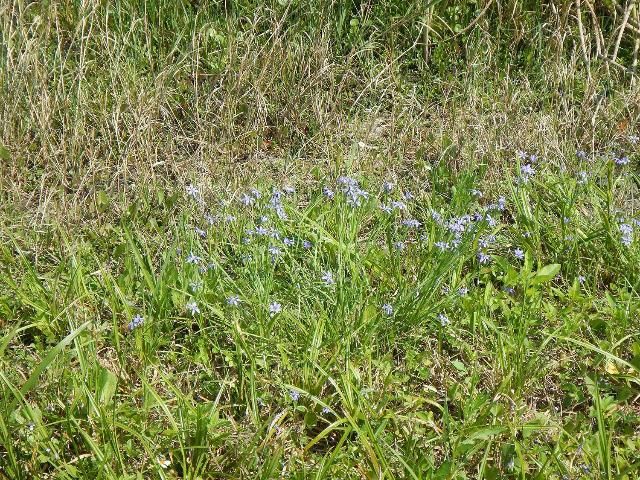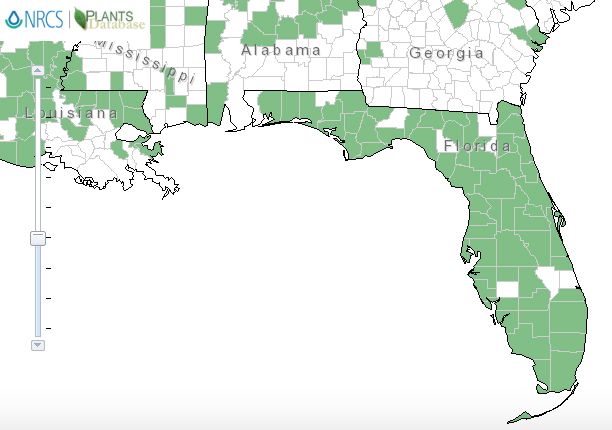Introduction
Blue-eyed grass is an herbaceous aquatic perennial native to Florida. This plant tends to grow in tufted, grass-like clumps that are 0.5 to 1 foot tall and 0.5 to 1 foot wide (Figure 1). It has narrow, linear leaves that form a fan-like base. Star-shaped flowers bloom on flattened stalks (bent scapes) a few inches above the leaves. Flowers stand erect above the leaves and are about 0.75 inches across (Figure 2). The short-lived flowers are radially symmetrical with three sepals and three petals. The yellow center on the blue flower has been referred to as an eye since Roman times (Austin 2004). Plants bloom profusely in the spring to early summer, but their flowers only have a lifespan of one day. Seeds are produced in tiny, brown, globe-shaped capsules. Blue-eyed grass is not considered salt-tolerant; it prefers a sand or loam soil with a slightly acidic to neutral pH.

Credit: Lyn Gettys, UF/IFAS

Credit: Lyn Gettys, UF/IFAS
Classification
Common Names
Narrowleaf blue-eyed grass, Bermuda blue-eyed grass, blue-eyed grass
Scientific Name
Sisyrinchium angustifolium Mill.
Synonyms
Sisyrinchium bermudiana, Sisyrinchium graminoides
Family
Iridaceae (Iris family) (USDA NRCS 2015)
Description and Habitat
Blue-eyed grass is a facultative wetland plant (USDA NRCS 2015). It is found throughout the eastern US, as far north as Newfoundland and Quebec, and as far west as Texas (USDA NRCS 2015). Its native habitat consists of meadows, damp fields, open woods, moist pinelands, swamp edges, and grassy roadsides. It prefers wet to moist meadows, marshes, shorelines, savannas, and woodland clearings (USDA NRCS 2015). Plants are hardy in USDA Zones 3 through 10 (Figure 3).

Credit: USDA NRCS
Propagation
Blue-eyed grass can be propagated through seeds or division. Seed capsules should be collected when they have darkened and become wrinkled. This plant will self-seed and should be sheared after blooming to prevent unwanted self-seeding and tidy the foliage. This plant may also be mowed. When transplanting seedlings, individual plants should be spaced 6 to 8 inches apart to allow plants to grow into each other to form a single mass. Division is recommended in early spring or fall every two to three years. Use a sharp edged tool to cut clumps into smaller pieces, then move the pieces to a moist location until the roots redevelop.
Other Uses
Blue-eyed grass can be used as a border plant. It is often used as groundcover because its foliage is low and neat even during periods when it has no flowers. It is best used in naturalized informal gardens and woodland gardens. It is also effective as an edge. Native Americans used the roots to make a tea to treat worms and stomach aches. The plant was used as a laxative to treat diarrhea in children as well. Most Sisyrinchium are considered laxatives and have been used by different tribes in North America to treat digestive problems (Austin 2004). That said, you should never eat field-collected plants. Many species have similar appearances but could be extremely toxic and deadly.
Summary
Blue-eyed grass has no serious insect or disease problems. It is best used in naturalized areas to attract bees, pollinators, prairie chickens, wild turkeys, songbirds, and other wildlife.
References
Austin, D. F. 2004. Florida Ethnobotany. Boca Raton: CRC Press.
Florida Native Plant Society. 2015. "Sisyrinchium angustifolium, pointed blue-eyed grass, Iridaceae." Accessed February 10, 2022. https://www.fnps.org/plant/sisyrinchium-angustifolium
Lady Bird Johnson Wildflower Center. 2015. "Sisyrinchium angustifolium Mill., narrowleaf blue-eyed grass, Iridaceae (iris family)." Lady Bird Johnson Wildflower Center NPIN: Native plant database. Accessed May 15, 2015. http://www.wildflower.org/plants/result.php?id_plant=SIAN3
USDA NRCS. 2015. "Plant profile for Sisyrinchium angustifolium (narrowleaf blue-eyed grass)." Accessed May 15, 2015. http://plants.usda.gov/core/profile?symbol=SIAN3
Wunderlin, R. P., and B. F. Hansen. 2008. "Atlas of Florida vascular plants." S. M. Landry and K. N. Campbell (application development), Florida Center for Community Design and Research. Tampa, FL: Institute for Systematic Botany, University of South Florida. Accessed on May 15, 2015. http://florida.plantatlas.usf.edu.